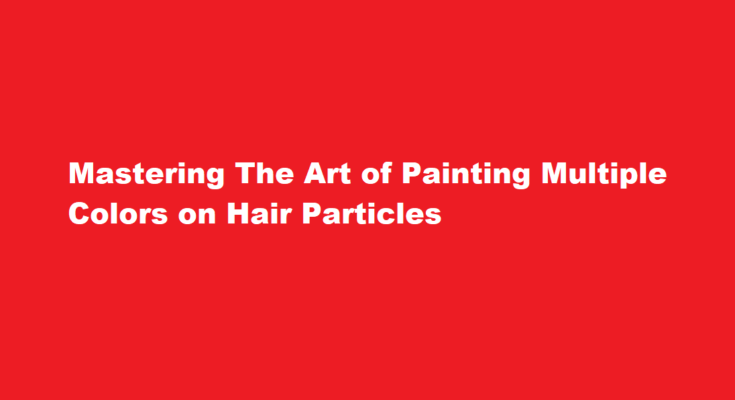Introduction
In the realm of computer graphics and 3D animation, hair particles play a crucial role in achieving realistic and visually appealing results. Whether you are working on an animated film, video game, or a digital art project, knowing how to paint multiple colors on hair particles can add a new level of sophistication to your creations. In this article, we will explore the techniques and methods to achieve stunning multicolored hair in your 3D models.
Understanding Hair Particle Systems
Before diving into the intricacies of painting multiple colors on hair particles, it’s essential to understand the fundamentals of hair particle systems. In 3D software, hair particles are simulated strands that mimic the appearance of hair in real life. They are governed by various parameters such as length, thickness, density, and color. The color of hair particles can be manipulated using textures, shaders, or vertex painting techniques.
Preparation – Setting Up Your 3D Scene
Begin by creating a 3D model of the character or object that requires multicolored hair. Once the model is ready, add a hair particle system to it. Most 3D software, such as Blender or Maya, provide built-in tools for creating and grooming hair particles.
Creating Hair Texture Maps
To paint multiple colors on hair particles, you’ll need to create hair texture maps. These maps will determine the distribution of colors along the hair strands. There are two main types of texture maps used for this purpose
1. Base Color Map This map defines the primary color of the hair. It acts as a foundation for the multicolored effect. Use software like Photoshop or GIMP to create this texture. Keep in mind the character’s design and the color palette of the scene.
2. Streak Map The streak map is where you’ll define the sections of the hair strands that will have different colors. It works like a mask that instructs the software on where to apply secondary colors. Paint streaks on the map, each representing a different color that you want to incorporate into the hair.
Applying Texture Maps to Hair Particles
Once your texture maps are ready, it’s time to apply them to the hair particle system. The process might vary slightly depending on the 3D software you are using, but the basic steps remain similar.
1. Base Color In your 3D software, navigate to the hair particle settings and find the option to add a base color texture. Load your Base Color Map onto the hair system. This will give the hair its primary color.
2. Streaks Next, apply the streak map you created. This map will determine which areas of the hair strands will showcase the secondary colors. The software will interpret the dark and light areas of the streak map as different colors, blending them along the length of the hair strands.
Adjusting Parameters for Realism
To achieve a natural look, it’s essential to tweak certain parameters within the hair particle system
1. Color Variation Add slight variations to the base color to avoid a uniform appearance. This will give the hair a more natural look.
2. Strand Thickness Experiment with different strand thicknesses, as thicker strands tend to display colors more prominently than thinner ones.
3. Randomness Introduce some randomness in color distribution to avoid a patterned appearance. This can be achieved by adjusting the streak map or using procedural noise textures.
Grooming and Styling
Grooming refers to the process of styling hair particles to achieve the desired look. Carefully groom the hair strands to ensure they flow naturally and complement the character’s design. Proper grooming can enhance the visibility of multicolored hair and make it stand out even more.
Final Touches – Lighting and Rendering
The way light interacts with hair significantly affects its appearance. Pay attention to the lighting setup in your scene to bring out the best of the multicolored hair. Experiment with different types of lights and their positions to achieve the desired effect.
When you’re satisfied with the look of your multicolored hair, set up the rendering settings to produce the final image or animation. Choose a high-quality output format and render your scene to see the stunning results.
FREQUENTLY ASKED QUESTIONS
Can you add texture to hair?
According to celebrity hairstylist Daniel Koye, every hair style responds to texture in a different way, but all can benefit from a little bounce. “Adding texture to your hair means that you want to add body and a visual separation to your hair,” he says. “Anybody can add visual texture to their hair.
How do you make hair textures?
An easy way to do this is by rubbing a small dollop of hair pomade in-between your fingers to warm up the product and then scrunching sections at your ends. This method helps to create random sections of texture allowing a more natural and authentic looking finish to your strands.
Conclusion
Painting multiple colors on hair particles can be a daunting task, but with practice and the right techniques, it can elevate your 3D projects to new heights. Remember to start with a solid understanding of hair particle systems and create well-designed texture maps. Fine-tune the parameters, groom the hair, and optimize the lighting to achieve a natural and visually captivating result. By following these steps, you’ll be well on your way to mastering the art of multicolored hair in your 3D creations.
Read Also : Mastering Efficiency Speedy Function Library Marking in IDA Pro



